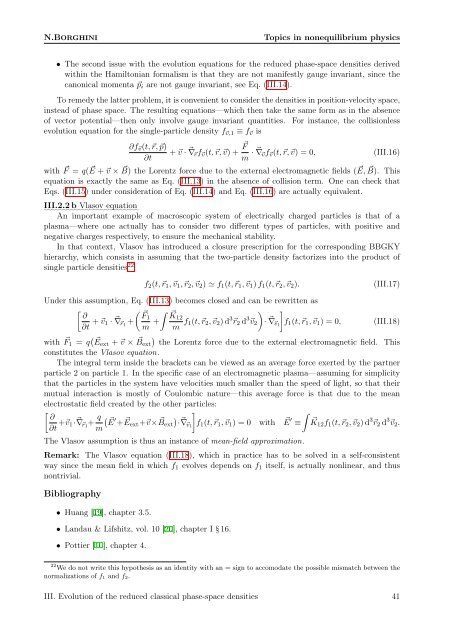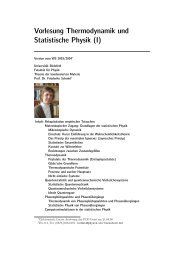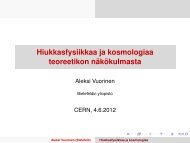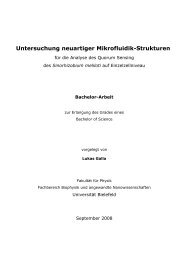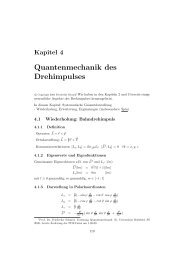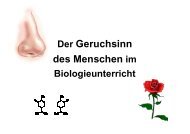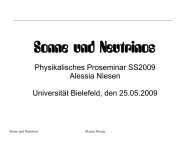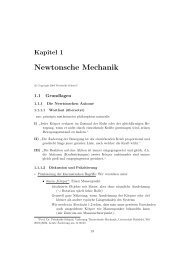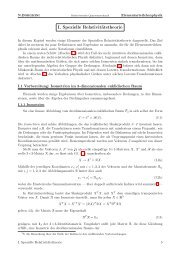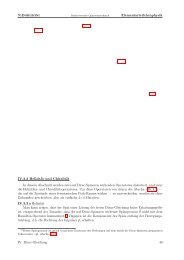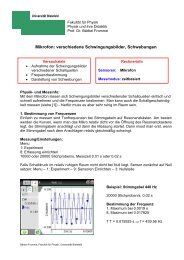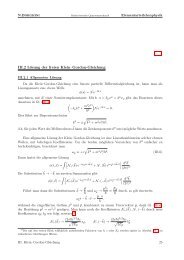Time evolution of reduced phase-space densities. BBGKY hierarchy
Time evolution of reduced phase-space densities. BBGKY hierarchy
Time evolution of reduced phase-space densities. BBGKY hierarchy
You also want an ePaper? Increase the reach of your titles
YUMPU automatically turns print PDFs into web optimized ePapers that Google loves.
N.BORGHINI Topics in nonequilibrium physics<br />
• The second issue with the <strong>evolution</strong> equations for the <strong>reduced</strong> <strong>phase</strong>-<strong>space</strong> <strong>densities</strong> derived<br />
within the Hamiltonian formalism is that they are not manifestly gauge invariant, since the<br />
canonical momenta pi are not gauge invariant, see Eq. (III.14).<br />
To remedy the latter problem, it is convenient to consider the <strong>densities</strong> in position-velocity <strong>space</strong>,<br />
instead <strong>of</strong> <strong>phase</strong> <strong>space</strong>. The resulting equations—which then take the same form as in the absence<br />
<strong>of</strong> vector potential—then only involve gauge invariant quantities. For instance, the collisionless<br />
<strong>evolution</strong> equation for the single-particle density fv,1 ≡ fv is<br />
∂fv(t, r, p)<br />
∂t<br />
+ v · ∇rfv(t, r, v) + F<br />
m · ∇vfv(t, r, v) = 0, (III.16)<br />
with F = q( E + v × B) the Lorentz force due to the external electromagnetic fields ( E, B). This<br />
equation is exactly the same as Eq. (III.13) in the absence <strong>of</strong> collision term. One can check that<br />
Eqs. (III.15) under consideration <strong>of</strong> Eq. (III.14) and Eq. (III.16) are actually equivalent.<br />
III.2.2 b Vlasov equation<br />
✿✿✿✿✿✿✿✿✿✿✿✿✿✿✿✿✿✿✿✿✿✿✿✿✿<br />
An important example <strong>of</strong> macroscopic system <strong>of</strong> electrically charged particles is that <strong>of</strong> a<br />
plasma—where one actually has to consider two different types <strong>of</strong> particles, with positive and<br />
negative charges respectively, to ensure the mechanical stability.<br />
In that context, Vlasov has introduced a closure prescription for the corresponding <strong>BBGKY</strong><br />
<strong>hierarchy</strong>, which consists in assuming that the two-particle density factorizes into the product <strong>of</strong><br />
single particle <strong>densities</strong>22 f2(t, r1, v1, r2, v2) f1(t, r1, v1) f1(t, r2, v2). (III.17)<br />
Under this assumption, Eq. (III.13) becomes closed and can be rewritten as<br />
<br />
∂<br />
∂t + v1 · ∇r1 +<br />
<br />
F1<br />
m +<br />
<br />
K12<br />
m f1(t, r2, v2) d 3 r2 d 3 <br />
v2 · <br />
∇v1 f1(t, r1, v1) = 0, (III.18)<br />
with F1 = q Eext<br />
+ v × <br />
Bext the Lorentz force due to the external electromagnetic field. This<br />
constitutes the Vlasov equation.<br />
The integral term inside the brackets can be viewed as an average force exerted by the partner<br />
particle 2 on particle 1. In the specific case <strong>of</strong> an electromagnetic plasma—assuming for simplicity<br />
that the particles in the system have velocities much smaller than the speed <strong>of</strong> light, so that their<br />
mutual interaction is mostly <strong>of</strong> Coulombic nature—this average force is that due to the mean<br />
electrostatic field created by the other particles:<br />
<br />
∂<br />
∂t +v1· q <br />
∇r1 + E ′<br />
+ Eext+v× <br />
m<br />
<br />
<br />
<br />
Bext · ∇v1<br />
f1(t, r1, v1) = 0 with E ′<br />
≡ K12f1(t, r2, v2) d 3 r2 d 3 v2.<br />
The Vlasov assumption is thus an instance <strong>of</strong> mean-field approximation.<br />
Remark: The Vlasov equation (III.18), which in practice has to be solved in a self-consistent<br />
way since the mean field in which f1 evolves depends on f1 itself, is actually nonlinear, and thus<br />
nontrivial.<br />
Bibliography<br />
• Huang [19], chapter 3.5.<br />
• Landau & Lifshitz, vol. 10 [20], chapter I § 16.<br />
• Pottier [10], chapter 4.<br />
22 We do not write this hypothesis as an identity with an = sign to accomodate the possible mismatch between the<br />
normalizations <strong>of</strong> f1 and f2.<br />
III. Evolution <strong>of</strong> the <strong>reduced</strong> classical <strong>phase</strong>-<strong>space</strong> <strong>densities</strong> 41


